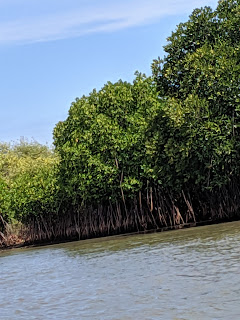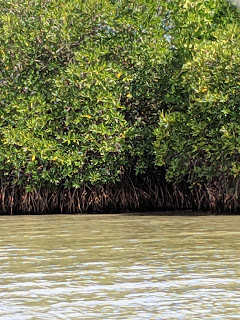My visit to Pichavaram in Tamil Nadu
I had been to Chidambaram several times in my childhood visiting my maternal grandparents and uncle during the summer holidays but never had a chance to visit this beautiful wetland Pichavaram located just 14 km away.
It was only in August 2019, when I went to Mahabalipuram from Mumbai for a friend’s son’s wedding, I could visit this beautiful huge water body in South India.
One of our family friends, Jaisri (Kalyani) who came with us for the
wedding said she wanted to fulfil her childhood dream of visiting
Pichavaram. She said her parents did not send her when her school in Chennai
had arranged an excursion trip to Pichavaram. To fulfil her dream, her
husband planned to take her and we also joined them.
Pichavaram is a village near Chidambaram in Cuddalore district and around 240 km from Chennai. Pichavaram is an estuarine mangrove situated at the confluence of Uppanar, a tributary of the Coleroon river. Aquaculture ponds, fishing villages and also agricultural croplands surrounded the area.
Mangroves are the climate change resilience component for coastal areas. It protects the land from ocean surges and seawater intrusion. Cities like Mumbai and Chennai are rapidly expanding and urbanising, destroying mangrove vegetation and giving way to environmental degradation. If a tsunami strikes once more the Indian coasts, it is very difficult to save these cities as the mangroves are not there to protect them.
Although in Mumbai, we had huge mangrove vegetation even till the 1990s, environmentalists could not do much to save the estuary and mangrove vegetation in the city. The builders’ lobby was very strong.
After seeing Pichavaram, I wondered how Mumbai missed an opportunity to save such huge mangrove vegetation and wetland to promote eco-tourism!
On August 25, 2019, we went to Pondicherry from Mahabalipuram and on August 27 morning we went to Chidambaram Nataraja temple on the way back to Pondicherry, went took a diversion to the Pichavaram village to visit one of the country's largest best-developed wetland and Mangrove vegetation.
We could have spent more time at Pichavaram, a typical swamp, extending
between Vellar and Coleroon estuaries, if we had only planned a proper trip
from Mumbai. Unfortunately, we had to rush back since we had to catch a
flight the following day from Chennai.
We took a motorboat (there were non-motorised boats also) to move around the estuary and witnessed the vast wetlands of India only for an hour and a half covering a distance of just three kilometres as a normal tourist. Later, I came to know from an ornithologist friend that I and my friends missed hundreds of routes available for boating and birdwatching through that huge wetland.
Pichavaram mangrove forest is located between two prominent estuaries---the Vellar estuary in the north and the Coleroon estuary in the south.According to the Indian Environment Ministry’s report, this wetland has 51 islets and the total area of the Vellar-Pichavaram-Coleroon estuarine complex is 2335.5 Hectares (Ha) of which 241 Ha is occupied by dense mangrove vegetation. Mangrove wetland occupied 1100 Ha while 1238.5 Ha occupied by barren high saline soil.
The mangroves also attract migrant and local birds including egrets, herons, spoonbills, storks and pelicans. About 177 species of birds belonging to 15 orders and 41 families have been recorded.
A high population of birds could be seen from November to January, both migrants from foreign countries and local migrants from their breeding grounds across India due to the high availability of prey, said one of the wetland officers there. Unfortunately, we could spot only one bird.
The availability of different habitat types such as channels, creeks, gullies, mudflats and sand flats and adjacent seashore in Pichavaram offers an ideal habitat for different species of birds and animals.
I wish I could visit Pichavaram leisurely soon.
Lalitha Vaidyanathan















Excellent writeup.i relived the experience.Thankyou
ReplyDelete